Who Registered Kirkland Coat Arms
| Coat of arms of Ireland | |
|---|---|
 | |
| Versions | |
 The imprint of arms, which serves as presidential standard | |
| Armiger | Ireland |
| Adopted | 1945 (registered: Arms of Ireland)[1] c.1541 (recorded: Kingdom of Ireland), c.1280 (recorded: King of Ireland) |
| Blazon | Azure a harp Or, stringed argent (Irish: Ar ghorm cláirseach órga na sreanga airgidí) |
| Earlier version(s) |  |
| Use | The harp is used on all Acts of Oireachtas; the seal of the President; the encompass of Irish passports; various government departments; the obverse of Irish gaelic euro coins. It is also used in the United kingdom, where information technology appears in the lower-left quadrant of the royal coat of artillery of the United Kingdom and is incorporated equally a badge into devices used past official bodies in Northern Republic of ireland. |
The coat of artillery of Ireland is blazoned every bit Azure a harp Or, stringed Argent (a gilt harp with silver strings on a blue background).[two] These arms take long been Ireland'south heraldic keepsake. References to them equally being the arms of the rex of Ireland can be found as early on as the 13th century. These arms were adopted by Henry Eight of England when he concluded the menses of Lordship of Republic of ireland and declared Ireland to be a kingdom again in 1541. When the crowns of England, Scotland and Ireland were united in 1603, they were integrated into the unified purple coat of arms of kingdoms of England, Scotland and Ireland. The harp was adopted as the emblem of the Irish Free State when it separated from the Uk in 1922. They were registered as the artillery of Republic of ireland with the Chief Herald of Ireland on ix November 1945.[one]
The delineation of the harp has inverse over time. When the arms were restored as the arms of the contained Irish state in 1922, a late-medieval Gaelic harp (a cláirseach), the Trinity College Harp, was used every bit a model.
Several variants of the arms of Republic of ireland be, including a heraldic badge and an infrequently used crest and torse. The Lordship of Ireland, the medieval realm of Ireland that existed between 1171 and 1541 under the English language crown, had a divide arms, which are blazoned Azure, iii crowns in pale Or, bordure Silvery (three aureate crowns ordered vertically on a blue groundwork with a white border). A variant of the arms of the ancient majestic province of Meath were likewise patently used at in one case as the arms of Ireland.
History [edit]

1702 map of Great United kingdom of great britain and northern ireland and Ireland with the artillery of Ireland, England, Scotland and French republic. The harp has a adult female's trunk and breasts.
As heraldry is essentially a feudal fine art, information technology was not until the Norman invasion of Republic of ireland in 1169 that Irish coats of arms came into existence, several decades after the art began to take seed in England and continental Europe. The earliest reference to a herald of arms for Republic of ireland was in 1392 on the creation of the commencement Republic of ireland King of Arms. The Republic of ireland Rex of Arms, which was under the English Higher of Arms, was succeeded by an independent Ulster Male monarch of Artillery, and an Athlone Pursuivant, in 1552, which despite its name had jurisdiction for artillery over all of Ireland. In 1943, the Ulster King of Arms was merged with the Norroy Male monarch of Artillery in England to form the Norroy and Ulster Rex of Arms. The office of the Chief Herald of Ireland was created equally successor to the Ulster King of Arms and the arms of Republic of ireland were registered past the Master Herald of Ireland on 9 November 1945.
However, reference to the harp as the arms of the king of Ireland can be found in one of the oldest medieval rolls of arms. The Wijnbergen Ringlet, a French coil of arms dating from c. 1280 and preserved in The Hague, Netherlands, attributed "D'azure a la harpe d'or" (English language: Blue with a harp of gold) to the King of Ireland ("le Roi d'Irlande").[3] [4] The harp, traditionally associated with the biblical King David, was a rare charge on medieval rolls and only two arms with a harp are listed in a collection of 19 early rolls.[5] Triangular devices appeared on medieval Irish gaelic coinage by kings John and Edward I in the 12th and 13th centuries. These devices may have been crude harps or information technology may be that the harp adult from the utilize of triangles to distinguish Irish coins.[vi] The idea of a harp being the arms of Ireland may take originated as a reference to a fictional grapheme, le roi d'irelande, in the courtly fable bike of Tristan. Alternatively, information technology may have derived from a celebrated 13th century bardic poem, Tabhroidh Chugam Cruit mo Riogh, dedicated to Donnchadh Cairbreach O'Briain (d. 1242), a Gaelic Rex of Thomond.[7]
Whatever its origins, the harp was adopted every bit the symbol of the new Kingdom of Ireland, established by Henry VIII, in 1541. A certificate in the Role of the Ulster Rex of Arms, from either the late reign of Henry VIII or the early reign his son of Edward VI, states that they were the arms of the kingdom of Ireland.[vii] The artillery were incorporated into the unified Royal Coats of Artillery of England, Ireland and Scotland upon the Union of the Crowns of the iii kingdoms in 1603. Upon the secession of the Irish Costless Country from the United Kingdom in 1922, the harp was taken as the keepsake of the independent Irish state.
Today, the image of the harp is used on the coins, passports and official seals of Ireland and is incorporated into the emblems of many bodies in Northern Ireland, such as the Police Service of Northern Ireland. The harp is ofttimes incorporated into the emblems of Irish companies, such as Guinness and Ryanair. It appears on the arms of countries with historical links to Ireland or the United Kingdom, such as Montserrat and Canada. In 1984, exemplars of the modernistic blueprint, approved by the Chief Herald, were registered by the Authorities of Ireland with the Globe Intellectual Property Organization nether Article 6ter of the Paris Convention, which relates to state emblems.[8] [9] [10] The government only registered "left-facing" images, with the harp'due south sound board on the right. While the Attorney General'southward role felt that right-facing images should also exist registered, patent agents advised this might exist interfere with Guinness Brewery'south utilise of such harps in its logo since the 1870s.[11]
Presidential Standard [edit]
Equally well as being the arms of Ireland, since 1945 the harp is the arms of each President of Republic of ireland whilst in office. Typically the artillery are borne as a imprint in the course of a Presidential Standard. The standard is flown over Áras an Uachtaráin, the President'due south residence in Dublin, at Dublin Castle when the President is in residence and on vehicles used by the President. As with other Presidential and Imperial Standards, it is never flown at half mast. However, the Presidential Standard never takes precedence over the flag of Republic of ireland, whereas, for instance, the Royal Standard of the United Kingdom takes precedence over the flag of the United kingdom.
Previous artillery [edit]
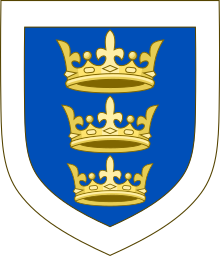
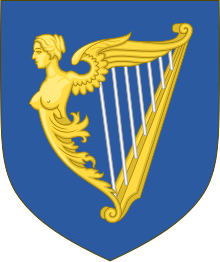
The Lordship of Republic of ireland, the medieval realm of Ireland that existed between 1171 and 1541 nether the English crown, had divide artillery. A commission of Edward Four in c. 1467-8 into the artillery of Ireland found them to exist blazoned Azure, three crowns in pale Or, bordure Silvery (iii golden crowns ordered vertically on a blue background with a white border).[7] [12] [xiii] The association of these artillery with Republic of ireland is probable to have originated with Irish magnates (both Norman and Gaelic) who fought in Edward I's Scottish wars at the plough of the 14th century. These were the artillery of Edmund the Martyr, which the Irish lords adopted as their banner in the aforementioned way as English lords identified with the banner of St. George. Withal, these arms were also well known in other medieval contexts and are often attributed to King Arthur.[seven]
Information technology is believed that the three crowns were abandoned as the arms of Ireland later on Henry 8's split with the Papacy. Strictly speaking, post-obit the Norman invasion of the 12th century, Ireland was a feudal possession of the Pope under the overlordship of the English monarch. The decision to alter the three crowns artillery may have sprung "from an idea that they might denote the feudal sovereignty of the pope" — whose tiara has three crowns — "whose vassal the king of England was, equally lord of Ireland."[3] [13]
Despite this, the retentiveness of the three crowns artillery may have remained for a time with one Elizabethan variant of the harp, sometimes found on coins, maps and seals as early every bit 1562, using of the three harps, 1 replacing each of the 3 crowns of the lordship'southward arms. This appears to take been a creation of the newly established Ulster King of Artillery and never captured the popular imagination sufficiently to replace the single Harp artillery that was in employ from the reign of Henry VIII. Thus, at the funeral cortège of Elizabeth I in 1603 depicted in a manuscript at the British Library, the Earl of Clanrickarde is shown carrying the banner of Ireland just as in the Wijnbergen Scroll.[7]
A variant of arms of the regal province of Meath were also evidently used at one time as the artillery of Ireland. Meath, now a part of the province of Leinster was in one case the province of the High Kings of Ireland. Its arms are of a rex sitting on a throne on a bluish field. The variant apparently used as the arms of Ireland were of a majesty on a sable (blackness) background instead of an azure (blue) field.[viii]
Achievement [edit]
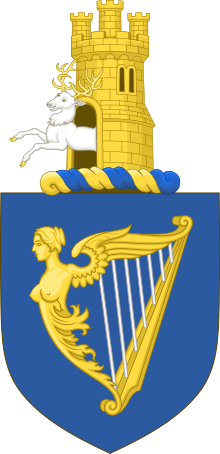

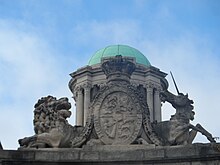
The design of the harp used past the modern Irish gaelic state is based on the Brian Boru harp, a belatedly-medieval Gaelic harp now in Trinity College, Dublin.[notation 1] The design is by an English language sculptor, Percy Metcalfe. Metcalfe's pattern was in response to a competition held by the land to pattern Irish gaelic coinage, which was to start circulation in December 1928. Metcalfe's design became the model for future official interpretations of the harp as an emblem of the country.[ citation needed ]
The modern design is markedly different from earlier depictions. During the 17th century, it became common to draw the harp with a adult female'south head and breasts, like a transport'southward figurehead, as the pillar.
It is not necessary to evidence a total complement of thirty strings, provided that the numbers exercise non fall below nine (yet the analogy to the left).[8] The strings are always silver and the harp is ever gold.
The harp is shown on a blue background. The colour of the field is sometimes called St. Patrick'southward blue, a proper name applied to shades of blue associated with Ireland. In current designs, used by the Britain and Irish states, the field is invariably a deep blue. The utilize of blue in the artillery has been associated with Gormfhlaith , a Gaelic mythological personification of Ireland. The discussion Gormfhlaith is a compound of the Irish words gorm ("blue") and flaith ("sovereign"); information technology is noted in early Irish gaelic texts as the proper name of several queens closely connected with dynastic politics in the tenth and 11th century Republic of ireland. The National Library of Ireland, in describing the blueish background of the arms, notes that in early Irish mythology the sovereignty of Ireland (Irish gaelic: Flaitheas Éireann) was represented by a adult female often dressed in a bluish robe.[8]
A crest, which was picayune used, is idea to have been created for the ascent of James I.[xiv] This crest was blazoned: A belfry triple towered or, from the portal a hart springing argent, attired and unguled also or.[xv] The torse was Or and azure.[xv] The torse and crest were apparently little used even during the menstruum of the Kingdom of Ireland. Unlike Scotland, Republic of ireland did non reserve the correct to bear a distinct coat of arms within the Uk. The crest and torse are not employed by the Irish state today.
Historically, the harp was frequently seen surmounted by a crown. In this example, the delineation is as heraldic badge, a device used to bespeak fidelity to or the holding of someone or something. Elizabeth I used the badge equally her 2nd Great Seal of 1586. This motif had earlier featured of the coins of the Lordship of Ireland during the Tudor menstruum and connected to exist used on the coins of the Kingdom of Ireland. Post-obit the creation of the United Kingdom, the device was used on the cap badges of the Imperial Irish Police and later on the Royal Ulster Constabulary. The bluecoat can be seen today on the cap badge of the Royal Irish Regiment of the British Army. The harp, unsurmounted by a crown, is used every bit a badge in the Republic of Republic of ireland today, but the harp surmounted by a crown is also found (eastward.one thousand. in 'colours' ties of Trinity College sports teams).
Supporters and motto [edit]

The heraldic badge of Ireland, created during the Tudor era, is distinguished from the arms of Ireland by being ensigned with a imperial crown.
The artillery of Ireland are without supporters. Nevertheless, historically, some depictions of the arms have been accompanied past various supporters. For example, during the late Tudor catamenia, depictions of the arms appeared accompanied by a dragon and a lion, representing Wales and England. The Tudors were monarchs of England but of Welsh descent. In later centuries, following the union of the crowns of England and Scotland, depictions appeared accompanied past a lion and a unicorn, representing England and Scotland. Other depictions included two stags, representing Ireland, or a stag and a panthera leo. However, none of these were ever a part of the blazon and should be interpreted in terms of creative licence.
Several mottos associated with Ireland and have too been used alongside representations of the harp, including the patriotic slogan, Erin Get Bragh (English: Ireland Forever), Quis separabit? (English: Who will separate [us]?), the motto of the Most Illustrious Club of Saint Patrick, and Information technology is new strung and shall exist heard, the motto of the Society of United Irishmen. However, no heraldic motto has ever been granted to Ireland and none ever accompanies the glaze of arms.
Light-green flag [edit]
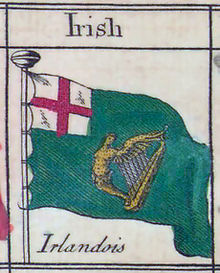
The unofficial dark-green ensign of Ireland from Bowles's Universal Brandish of the Naval Flags of all Nations maritime flag chart, 1783
Equally well equally the coat of arms, which shows the harp on an Azure (blue) field, Ireland has long been associated with a flag also bearing the harp. This flag is identical to the coat of arms but with a dark-green field, rather than blueish, and is blazoned Vert, a Harp Or, stringed Argent (a gold harp with silvery strings on a light-green field).
The earliest-known record of the green flag is attributed to Eoghan Ruadh Ó Néill, a 17th-century exile and soldier in the Irish gaelic brigade of the Spanish army. His ship, the St. Francis, is recorded equally flying from her mast top "the Irish harp in a green field, in a flag" as she lay at anchor at Dunkirk en route to Ireland.[viii] Ó Néill was returning to Ireland in order to participate in the Irish Confederate Wars (1641–1653), during the Wars of the Three Kingdoms (a series of ceremonious wars engulfing England, Ireland and Scotland), where he would contribute as a leading general. Variants of the green flag were flown by United Irishmen during the 1798 Rebellion and past the Irish gaelic émigré in foreign armys, such as the Irish Brigade of the Union Army during the American Civil War (1861–1865) and Saint Patrick'due south Battalion in the Mexican Army during the Mexican–American War (1846–1848).
Although the Kingdom of Republic of ireland never had an official flag, this flag is recorded equally the flag of Ireland past 18th- and 19th-century sources. It was used every bit a naval jack and as the ground for the unofficial green ensign of Republic of ireland, particularly during the 18th and 19th centuries. The flag is identical to the artillery of the province of Leinster. It is believed that the Leinster arms are derived from it, rather than the other way around.
Artillery and Flag of the Four Provinces [edit]

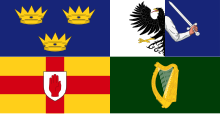

1651 provincial arms of Ireland, as seen on a map of Galway.[16] In the heart is the arms of Mide, while the third quarter features the arms of Hugh de Lacy (Earl of Ulster from 1205 – 1243) to correspond Ulster.
The arms of the iv traditional provinces of Ireland are popularly displayed quartered equally arms of Ireland. The quartering is commonly in the order Leinster first, Connacht second, Ulster third and Munster fourth. The resulting arms are frequently displayed in the course of a banner. They as well appear as charges in other arms and emblems. For example, the arms of the Genealogical Office, which is headed by the Principal Herald of Ireland, are the 4 provinces shown quartered beneath a chief Gules, charged with a Tudor Portcullis Or between two Scrolls Silver (a reddish band with a gold Tudor portcullis between two silver scrolls).[7]
The arms of Leinster (Vert, a Harp Or, stringed Argent) are believed to have likely evolved from the arms of Ireland itself with a change of tincture. Similarly, Munster'southward arms (Azure, 3 antique crowns Or) are idea to accept been derived from those of the onetime Lordship of Ireland, or from the brusk-lived dukedom of Republic of ireland created for Robert de Vere in 1386. The crowns now normally depicted as "antiquarian" or "eastern": a gold rim with eight precipitous, triangular rays, of which 5 are seen.[17]
The artillery of Ulster are the artillery of the de Burgh, Earls of Ulster, combined with the crimson mitt seal of the O'Neills. These two dynasties and symbols are inseparably linked to Ulster. The combination of them is blazoned Or, on a Cross Gules, an inescutcheon Argent, charged with a dexter paw erect aupaumee and couped at the wrist Gules.[7]
Finally, Connacht'southward arms are blazoned Party Per Stake Silverish and Azure, in the start an eagle dimidiated and displayed Sable in the second issuant from the partition an arm embowed and vested, the paw holding a sword erect, all Silverish. These are believed to have been adopted from the artillery of the medieval Schottenklöster (Gaelic monastery) in Regensburg, Federal republic of germany. The artillery of the Regensburg Schottenklöster, which date from at least the 14th century, combined the arms of the Holy Roman Emperor (from whom the abbey received protection) dimidiated with a symbol that may be linked with the crest of the O'Brien dynasty arms (an 11th-century O'Brien is listed as the "fundator" of the abbey). The arms may take been granted to Ruaidrí Ua Conchobair, King of Connacht and the terminal High Rex of Ireland before the Norman invasion, by the abbey as a gift to return his patronage. The artillery were given as the "old tyme arms" of Republic of ireland by the Athlone Pursuivant, Edward Fletcher, c. 1575 and, with slight change of tinctures, became the artillery of Connacht in the seventeenth century.[7]
Run across also [edit]
- Armorial of Ireland
- Coat of arms of Northern Ireland
- Flag of Republic of ireland
- Great Seal of the Irish Free Land
- Irish heraldry
- List of flags of Ireland
- Seal of the President of Republic of ireland
- Shamrock
Notes [edit]
- ^ The Trinity College Harp was once thought to accept belonged to Brian Boru, the 11th century High King of Ireland. Notwithstanding, the harp has since been dated to the 14th or 15th century and so cannot have really belonged to him. It is on permanent display in the Long Room of the library of Trinity College, Dublin
References [edit]
- ^ a b Genealogical Office (9 Nov 1945). "Grant of Arms (Registration): Artillery of Ireland". Catalogue. National Library of Republic of ireland. G.O. MS 111G; folio twenty. Archived from the original on eighteen May 2013.
- ^ "Heraldry in Ireland, 1943-2018". The National Library of Ireland.
- ^ a b Michael C. O'Laughlin, 2001, The Irish Book of Artillery, Irish Genealogical Clan, p xv
- ^ Hartemink, Ralf (1996). "Civic Heraldry of Republic of ireland, National arms of Ireland". Heraldry of the Earth. ngw.nl. Archived from the original on 9 June 2011. Retrieved thirteen July 2011.
- ^ Velde, François. "Heraldry in Ireland". Heraldica.
- ^ William Henry Grattan Inundation, 1905, The Story of the Harp; James Simon, 1810, Simon's Essay on Irish coins, and of the currency of foreign monies in Ireland
- ^ a b c d e f g h Kennedy, John (Autumn 1991), "The Arms of Ireland: Medieval and Mod", Coat of Artillery (155)
- ^ a b c d e Carragin, Eoin (18 April 2007). "Heraldry in Ireland" (PDF). National Library of Ireland. p. 3. Retrieved 17 March 2008.
- ^ "Glossary". Irish Patents Office. pp. Commodity 6ter. Retrieved 31 May 2013.
- ^ "C.4304-551" (PDF). WIPO Circular (4304). 15 February 1985. Archived from the original (PDF) on 4 March 2016. Retrieved 31 May 2013.
Images: IE1 Archived 19 February 2013 at the Wayback Machine IE2 Archived 4 March 2016 at the Wayback Machine IE3 Archived three March 2016 at the Wayback Machine IE4 Archived 3 March 2016 at the Wayback Machine IE5 Archived four March 2016 at the Wayback Machine IE6 Archived 4 March 2016 at the Wayback Machine IE7 Archived 4 March 2016 at the Wayback Machine IE8 Archived 4 March 2016 at the Wayback Automobile IE9 Archived 4 March 2016 at the Wayback Motorcar IE10 Archived 4 March 2016 at the Wayback Machine - ^ Humphreys, Joe (28 Dec 2013). "Country feared Guinness objections over programme to brand harp logo a trademark". The Irish gaelic Times. p. 1. Retrieved 29 December 2013.
- ^ W. Thousand. Perrin and Herbert S. Vaughan, 1922, "British Flags. Their Early History and their Evolution at Sea; with an Account of the Origin of the Flag as a National Device", Cambridge University Press: Cambridge, pp. 51–52
- ^ a b Chambers's Encyclopædia: A Lexicon of Universal Knowledge, 1868, p. 627
- ^ Questions and Answers, Notes and Queries, 1855, p. 350
- ^ a b Fox-Davies, A.C., 1915, The Book of Public Arms, London
- ^ "17th Century Pictorial Map of Galway City". Archived from the original on i November 2018. Retrieved xiii November 2018.
- ^ Boutell, Charles; Pull a fast one on-Davies, A. C. (1914), The Handbook to English language Heraldry (Illustrated 11th ed.), Teddington, United kingdom: The Echo Library, p. 160, ISBN978-1-4068-2770-v
External links [edit]
- Office of the Chief Herald of Ireland
- 2 "Ireland" images in Ulster Office'south Draft Grants of Arms ca. 1580–1690: folio 18 (top left) and folio 71
Who Registered Kirkland Coat Arms,
Source: https://en.wikipedia.org/wiki/Coat_of_arms_of_Ireland
Posted by: skaggswoustravight73.blogspot.com


0 Response to "Who Registered Kirkland Coat Arms"
Post a Comment